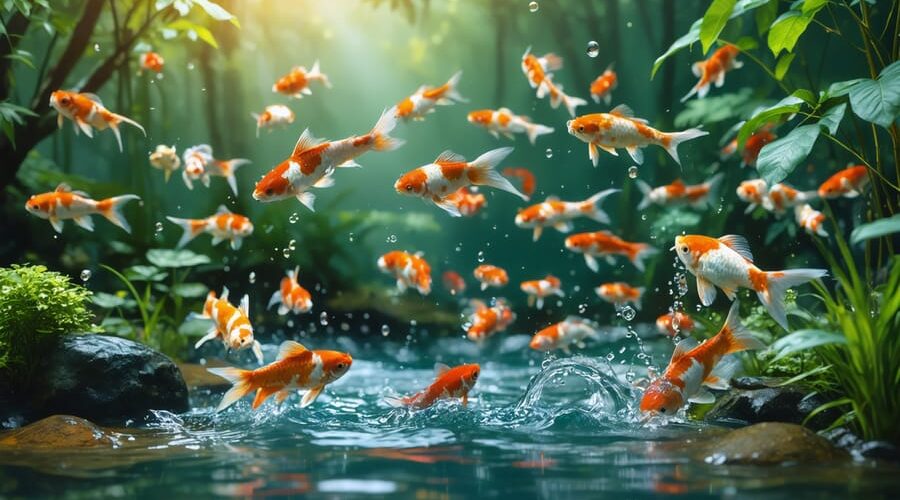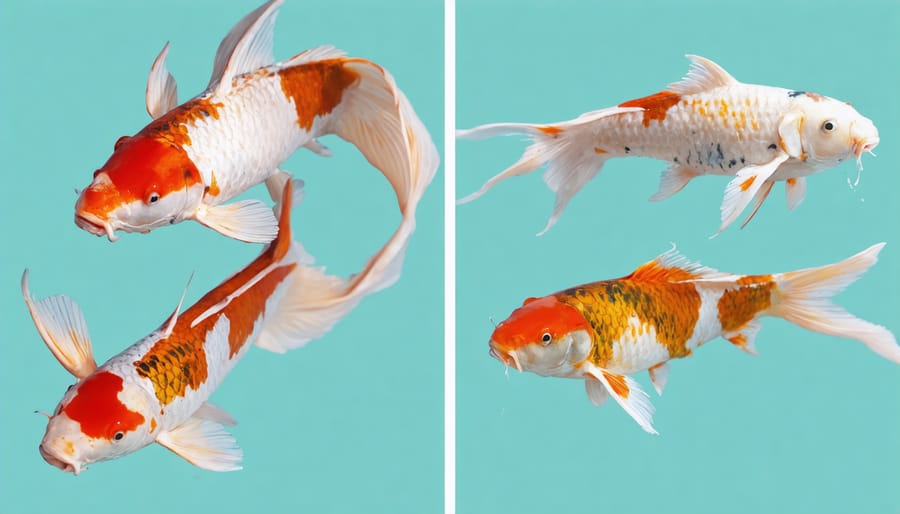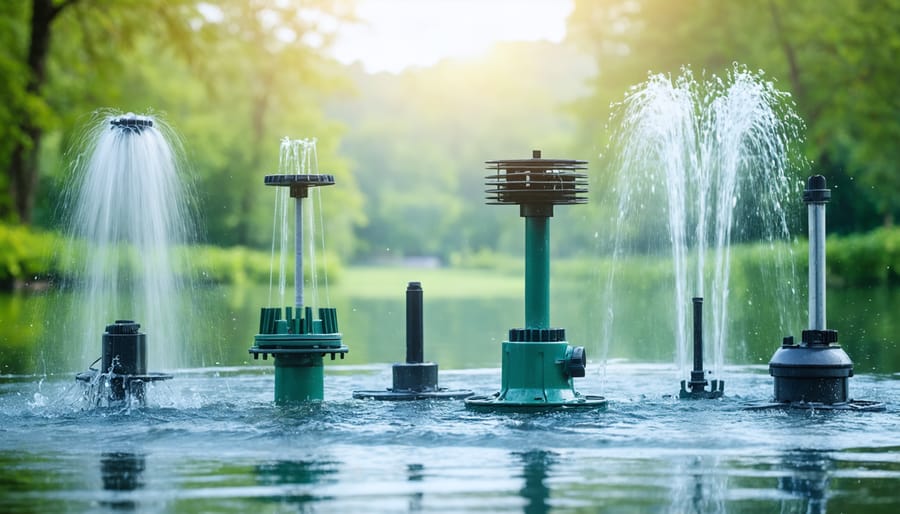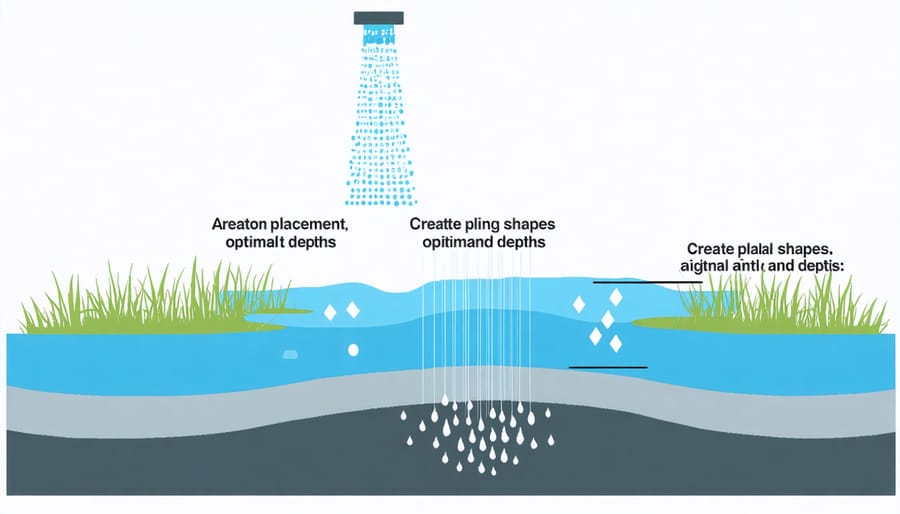
Transform Your Koi Pond: Simple Aeration Secrets for Healthier, Happier Fish
Proper aeration transforms a struggling koi pond into a thriving aquatic ecosystem. Beyond simply adding oxygen, a well-designed aeration system creates essential water circulation, breaks down harmful compounds, and supports your koi’s immune health. For pond owners, aeration represents the difference between constantly battling water quality issues and maintaining a crystal-clear pond where koi flourish year-round.
The physics of oxygen exchange might seem complex, but the fundamental principle remains simple: koi need consistent, abundant dissolved oxygen to thrive. Whether you’re managing a small backyard pond or a large-scale water garden, implementing the right aeration solution directly impacts everything from fish health to algae control. Modern aeration systems combine energy-efficient air pumps, strategically placed diffusers, and advanced monitoring capabilities to create optimal living conditions for your prized koi.
Let’s explore how proper aeration not only keeps your fish healthy but also reduces maintenance time, cuts down on algae growth, and helps maintain stable water parameters throughout changing seasons. Understanding these core principles will empower you to make informed decisions about your pond’s aeration needs.
Why Your Koi Need Proper Aeration
Oxygen Levels and Fish Health
Proper oxygen levels are crucial for the health and happiness of your koi fish. When oxygen levels are optimal, you’ll notice your koi displaying energetic behavior, actively swimming throughout the pond, and eagerly coming to the surface during feeding times. These are just some of the many benefits of pond aeration for your aquatic friends.
Low oxygen levels can cause visible stress in koi, leading them to gather near the surface or around waterfalls, gasping for air. They might become sluggish, lose their appetite, or show reduced activity levels. In severe cases, insufficient oxygen can even be fatal to your precious koi.
The ideal oxygen level for koi ponds should be maintained between 6-8 mg/L (milligrams per liter). During warmer months, when water holds less oxygen naturally, proper aeration becomes even more critical. Your koi will tell you if they’re getting enough oxygen through their behavior – happy, active fish are usually well-oxygenated fish!

Water Quality Benefits
Proper aeration is the cornerstone of a healthy koi pond, playing a vital role in maintaining proper water chemistry and creating an optimal environment for your fish. When air is pumped into your pond, it creates essential water movement that helps break down harmful compounds like ammonia and nitrites, which can be toxic to your koi.
The bubbles from your aerator don’t just look pretty – they’re hard at work distributing oxygen throughout the water column. This oxygen-rich environment supports beneficial bacteria that naturally clean your pond and break down fish waste and decaying plant matter. Think of these bacteria as your pond’s cleanup crew, working 24/7 to keep the water healthy.
Beyond oxygen distribution, aeration prevents water stagnation and reduces algae growth by keeping the water moving. It also helps maintain consistent water temperatures throughout your pond, preventing harmful temperature layers that can stress your koi. During winter, aeration keeps vital gas exchange happening even when the surface is frozen, ensuring your fish have the oxygen they need to thrive year-round.

Essential Aeration Equipment for Koi Ponds
Surface Aerators
Surface aerators are popular among koi pond enthusiasts for their dual benefits of oxygenation and visual appeal. These devices float on the water’s surface, creating dramatic fountain-like displays while introducing vital oxygen into your pond. When it comes to choosing effective aerators, you’ll find options ranging from simple floating units to more elaborate fountain-style systems.
The most common types include floating fountain aerators, which create beautiful water displays while mixing air into the water, and surface splashers, which focus more on functionality than aesthetics. Installation is typically straightforward – most units can be placed directly in the pond and connected to a power source on the shore.
For best results, position your surface aerator in the center of the pond where it can create maximum circulation. Remember to consider your pond’s size when selecting a unit – a good rule of thumb is one surface aerator for every 1,000 gallons of water. During winter, you might need to remove surface aerators to prevent ice damage, making them more suitable for warmer climates or seasonal use.
Bottom Diffusers
Bottom diffusers are among the most effective aeration solutions for koi ponds, especially for deeper waters. These devices sit at the pond’s lowest point, releasing fine bubbles that rise through the entire water column, maximizing oxygen distribution. As the bubbles travel upward, they create a lifting effect that pulls oxygen-poor water from the bottom to the surface, where it can be refreshed.
The most common types are weighted disc diffusers and rubber membrane diffusers. Disc diffusers typically produce smaller bubbles and offer excellent coverage, making them ideal for larger ponds. Rubber membrane diffusers are more budget-friendly and work well in smaller setups, though they may need more frequent cleaning.
For optimal performance, position bottom diffusers in the deepest parts of your pond. One diffuser can effectively aerate about 100 square feet of surface area, though this varies based on pond depth and shape. During installation, ensure the airline is securely anchored to prevent floating and that the diffuser sits level on the pond bottom for even bubble distribution.
Remember to clean your diffusers seasonally to prevent clogging from debris and mineral buildup, which can reduce their efficiency over time.
Air Pumps and Compressors
Choosing the right air pump or compressor for your koi pond is crucial for maintaining healthy oxygen levels. For small ponds under 1,000 gallons, a standard aquarium-style air pump rated at 2-3 watts per 100 gallons usually suffices. Medium-sized ponds between 1,000-5,000 gallons benefit from linear air pumps, which offer better efficiency and durability.
For larger koi ponds over 5,000 gallons, rotary vane or diaphragm compressors are your best bet. These robust units can handle multiple air stones and provide consistent airflow even at greater depths. When selecting your equipment, consider these key factors:
– Pond volume (gallons or cubic feet)
– Maximum depth (deeper ponds need stronger pumps)
– Number of desired aeration points
– Running costs (electricity usage)
– Noise levels (especially if near living areas)
A good rule of thumb is to slightly oversize your air pump rather than undersize it. This provides a safety margin during hot summer months when oxygen demands are highest. For example, if your calculations suggest you need a 20-watt pump, consider getting a 25-30 watt unit.
Remember that higher-quality pumps, while more expensive initially, often prove more cost-effective in the long run through better energy efficiency and longer lifespan. Look for models with weather-resistant housings if you’ll be placing the pump outdoors.
Optimizing Your Aeration Setup
Placement Strategies
Strategic placement of your pond aerators is crucial for maintaining healthy oxygen levels throughout your water feature. The most effective location is typically in the deepest part of your pond, as this is where oxygen levels tend to be lowest. For rectangular ponds, position your aerator about one-third of the way from the end where the water is deepest. This creates a natural circulation pattern that benefits the entire pond.
In circular or oval ponds, central placement usually works best, slightly off-center toward the deeper end if your pond has varying depths. For ponds with multiple sections or irregular shapes, you might need several smaller aerators rather than one large unit. Place these in each major section to ensure complete coverage.
Consider your pond’s features when deciding on placement. Keep aerators away from waterfalls or fountains, as these areas already receive natural aeration. Instead, focus on still areas or spots where fish tend to congregate. During summer months, when oxygen levels are naturally lower, you might want to position aerators slightly higher in the water column to create more surface movement.
If you have bottom drains, place aerators at least 3-4 feet away to prevent interference with drainage. For koi ponds specifically, ensure the aerator doesn’t create too strong a current in areas where fish like to rest. The goal is to create gentle, consistent circulation throughout the entire pond without causing stress to your fish.

Seasonal Adjustments
Proper aeration adjustment throughout the seasons is crucial for maintaining a healthy koi pond environment. During spring, as temperatures begin to rise, gradually increase aeration levels to support the growing activity of your koi. This is when they become more active and require additional oxygen to thrive.
Summer demands the highest aeration levels, as warm water holds less dissolved oxygen. During hot months, run your aerators at maximum capacity, especially during early morning hours when oxygen levels are naturally at their lowest. Consider adding an additional air stone or increasing pump output during heatwaves.
As autumn approaches, begin reducing aeration levels gradually to match your koi’s decreasing activity. However, maintain sufficient circulation to prevent leaves and debris from settling at the bottom of your pond.
Winter pond maintenance requires special attention to aeration. While you might think less aeration is needed during colder months, maintaining some airflow is essential to prevent complete surface freezing and allow toxic gases to escape. Position air stones slightly higher in the water column to prevent disturbing the warmer bottom layer where koi tend to gather during winter.
Remember to check your aeration system weekly during seasonal transitions and adjust gradually rather than making sudden changes, which could stress your koi. Keep an eye on your fish’s behavior – if they’re gasping at the surface, it’s a sign that you need to increase aeration immediately.
Maintenance Tips
Regular maintenance of your koi pond aeration system is crucial for keeping your fish healthy and your pond water crystal clear. Start by checking your air pump weekly for unusual noises or vibrations that might indicate problems. Clean or replace the air filters every month to prevent dust and debris from damaging the pump motor.
Inspect your air stones or diffusers quarterly for calcium buildup or algae growth. If you notice reduced bubble production, soak the diffusers in a vinegar solution for a few hours to dissolve mineral deposits. Remember to check all air tubing connections monthly for leaks by looking for unusual bubbles or listening for hissing sounds.
During winter months, ensure your air pump is protected from the elements but still has adequate ventilation to prevent overheating. If you’re using a cabinet or cover, check regularly for moisture buildup that could damage the equipment.
Keep a maintenance log to track when you perform these tasks and note any issues you discover. This helps you establish patterns and anticipate when equipment might need replacement. For optimal performance, consider replacing air stones annually and checking diaphragms in air pumps every two years.
Don’t forget to clean the area around your air pump regularly to prevent debris from blocking air intake. A well-maintained aeration system runs more efficiently and lasts longer, saving you money while keeping your koi happy and healthy.
Troubleshooting Common Aeration Issues
Even the best-maintained aeration systems can occasionally encounter issues. Let’s explore common problems and their solutions to keep your koi happy and healthy.
If you notice weak or uneven bubbles, first check for kinked or bent air lines. Straightening these out often solves the problem. Also, inspect the air stones for clogging – calcium buildup and algae are usual culprits. Soak them in a vinegar solution for a few hours to dissolve deposits, then rinse thoroughly before reinstalling.
When your air pump starts making unusual noises, it typically indicates worn-out diaphragms or valve plates. These parts naturally deteriorate over time and usually need replacement every 12-18 months. Regular maintenance can prevent sudden failures, so mark your calendar for annual checkups.
Low oxygen levels despite running aeration can be frustrating. Check that your pump isn’t overwhelmed – if you’ve added more fish or plants, you might need additional capacity. During summer, when oxygen demands are highest, consider running a backup system or adding a second air pump for insurance.
Air stones suddenly stopping? The check valve might have failed, allowing water to flow back into your pump. Installing a new check valve is an easy fix that prevents future pump damage. Remember to position check valves above the water line for best results.
For winter operation, condensation in air lines can freeze and block airflow. Installing a condensation trap near the pump helps collect moisture before it becomes problematic. If you live in a cold climate, consider moving your air pump indoors or using an insulated housing to prevent performance issues.
Most importantly, don’t wait until problems become severe. Regular system checks and maintenance prevent many common issues before they affect your koi’s health. Keep spare parts on hand, and you’ll be prepared for quick fixes when needed.
Proper aeration is the lifeline of a healthy koi pond, making it essential for any pond owner to implement and maintain an effective system. By ensuring adequate oxygen levels through surface agitation and deep-water aeration, you’ll create an environment where your koi can thrive while maintaining crystal-clear water quality. Remember that the size and depth of your pond, along with your local climate, should guide your choice of aeration equipment. Whether you opt for air pumps, waterfalls, or fountains, regular maintenance and monitoring are key to success. Take the time to plan your aeration system carefully, and don’t hesitate to adjust it as your pond’s needs change throughout the seasons. Your koi will reward you with vibrant colors, active behavior, and years of enjoyment in their well-oxygenated habitat.
